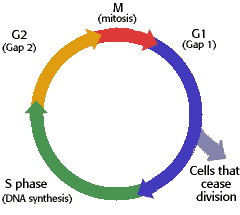
The Cell Cycle-Video tutorial
February 19, 2009 The Cell Cycle-Video tutorial
The Cell Cycle-Video tutorial
The cell cycle, or cell-division cycle, is the series of events that take place in a cell leading to its replication. In prokaryotes, the cell cycle occurs via a process termed binary fission. In eukaryotes, the cell cycle can be divided in two brief periods: interphase—during which the cell grows, accumulating nutrients needed for mitosis and duplicating its DNA—and the mitotis (M) phase, during which the cell splits itself into two distinct cells, often called “daughter cells”. The cell-division cycle is a vital process by which a single-celled fertilized egg develops into a mature organism, as well as the process by which hair, skin, blood cells, and some internal organs are renewed.
Cell Division cycle: Prokaryotes-Binary fission
Binary fission is the form of asexual reproduction and cell division used by prokaryotic organisms (such as bacteria or archaea). This process results in the reproduction of a living prokaryotic cell by division into two parts which each have the potential to grow to the size of the original cell.
Cell cycle: Eukaryotes
The cell cycle is an ordered set of events, culminating in cell growth and division into two daughter cells. Non-dividing cells not considered to be in the cell cycle. The stages, pictured to the left, are G1-S-G2-M. The G1 stage stands for “GAP 1”. The S stage stands for “Synthesis”. This is the stage when DNA replication occurs. The G2 stage stands for “GAP 2”. The M stage stands for “mitosis”, and is when nuclear (chromosomes separate) and cytoplasmic (cytokinesis) division occur. Mitosis is further divided into four phases.
